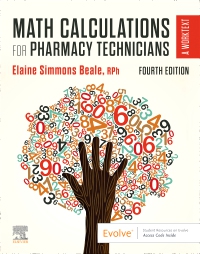
Math Calculations for Pharmacy Technicians Elsevier eBook on VitalSource, 4th Edition
Elsevier eBook on VitalSource

Help your students master the math skills needed to calculate drug dosages safely and accurately! Math Calculations for Pharmacy Technicians, 4th Edition covers the competencies required by the American Society of Health-System Pharmacists (ASHP). Designed specifically for Pharmacy Technicians, the book includes a review of basic math, conversions between measurement systems, interpretation of drug labels and physicians' orders, and calculation of medications based on a patient's age, body weight, or body surface area. Two basic methods of drug calculation are described: ratio/proportion and dimensional analysis. With step-by-step guidance and hundreds of practice problems, this practical worktext helps students develop calculation confidence and prepare for successful careers.
Newer Edition Available
Math Calculations for Pharmacy Technicians - Elsevier eBook on VitalSource
-
- NEW! Coverage of compounding medications along with newer products such as biologicals used to treat chronic disease or anticoagulants that are alternatives to warfarin and heparin
- NEW! Expanded case-based problems with realistic drug labels, simulating practice and allowing realistic application
- NEW! Appendix of top 200 commonly prescribed medications also available online as a printable document for on-the-job reference
- More than 1,800 practice problems to help students achieve skills mastery and speed with calculations, conversions, and measurements
- Step-by-step examples following the written explanation of a calculation to break down complex formulas into more manageable building blocks
- Chapter pretests and posttests to help students assess their comprehension as well as areas of strength and areas for improvement
- Learning features including safety alerts to prevent common pharmacy and medication errors, tech notes to highlight important concepts, and application to on-the-job situations
- UNIQUE! Body system icons next to medication names to help students learn to associate drugs with their respective disorders and body systems
- Key terms including definitions and are accompanied by a back-of-book glossary for reference
-
- NEW! Coverage of compounding medications along with newer products such as biologicals used to treat chronic disease or anticoagulants that are alternatives to warfarin and heparin
- NEW! Expanded case-based problems with realistic drug labels, simulating practice and allowing realistic application
- NEW! Appendix of top 200 commonly prescribed medications also available online as a printable document for on-the-job reference
-
Section I: Introduction and Basic Math Skills
1. Assessment of Mathematical Skills Needed in Health Occupations
2. Review of Basic Mathematical Skills
Section II: Measurements Used in Health Care and Conversions between Measurement Systems
3. Conversion of Clinical Measurements of Numbers, Time and Temperature
4. Comparisons of Measurement Systems
5. Conversions between Measurement Systems
Section III: Medication and Prescription Orders and Their Calculations
6. Interpretation of Medication Labels and Orders
7. Calculation of Solid Oral Doses and Dosages
8. Calculate Doses of Liquid Oral and Parenteral Medications
9. Reconstitution of Powders or Crystals into Liquid Medications
Section IV: Special Medication Calculations
10. Calculation of Medications for Special Populations Based on Body Weight and Patient Age
11. Calculation of Medications Measured in Units, Milliequivalents and Percents of Concentration
12. Calculation of Medications for Intravenous Uses
13. Calculation of Mixtures from Stock Medications
14. Interpreting Physician's Orders for Dosages
Section V: Business Math
15. Business Math for Pharmacy TechniciansAppendices Answer Key (every third problem only)
Bibliography



 as described in our
as described in our 